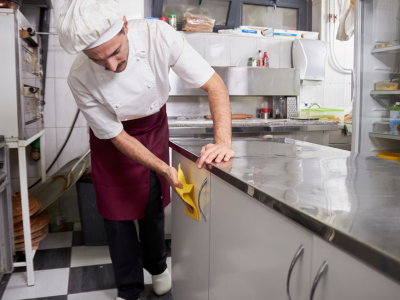From massive fast-food chains to small pop-up bakeries, commercial-grade kitchen equipment should meet strict requirements to provide consumers with healthy and safe food. As a restaurant owner, it is important to not take any shortcuts when it comes to maintaining the commercial kitchen. In this article, we have curated a template that can help you ensure that your commercial kitchen is properly maintained.
What is a Commercial Kitchen Maintenance Checklist?

A commercial kitchen maintenance checklist is used by restaurant managers as well as head chefs to confirm that every part of the kitchen is working properly. Every kitchen has different maintenance needs. So there’s not necessarily a one-size-fits-all template. Due to this reason, many top-performing restaurant owners and managers integrate online platforms to create custom kitchen maintenance checklists that cater to the unique needs of their kitchens.
But maintaining commercial-grade kitchen equipment can often be an overwhelming task for the staff due to the different types of equipment available.
Specific Equipment Maintenance and Cleaning
Preventive maintenance is the key to keeping the kitchen up and running. Proper equipment maintenance can help in averting costly repairs and prevent health and safety violations. Every kitchen maintenance and cleaning checklist can look slightly different, but should cover the following critical areas
1. Griddles & Grills
Many commercial kitchens use griddles and grills to cook different meals a day. They are easy to use and clean. They also help maximize space in the kitchen. Here are a few elements to add to the checklist regarding grills and griddles:
- Wipe the griddles and grills after use
- Clean the grill burners
- Check grease filters at regular interval
2. Dishwashers & Sinks

Whether you hand wash the dishes and cookware or use a commercial-grade cleaning system, the systems used form an important part of maintaining a clean, safe, and orderly kitchen. Some things to add to the checklist include:
- Cleaning the filters every 15-20 cycles
- Training employees to rinse food and debris from plates and cookware and then loading the dishwasher to prevent clogs and drainage issues.
- Check detergent, sanitizer, and rinsing aids levels
- Inspect tank water regularly
3. Fryers
Gas or electric fryers are an important element of any kitchen that helps in serving large quantities of fried foods. Countertop fryers help in maximizing floor space for smaller kitchens and diners. Whereas larger and busier kitchens should use multiple floor models to keep up with the demand for fried foods. The maintenance checklist is as follows:
- Extract dirty oil regularly
- Clean fry baskets
- Inspect the fryers for damages
- Check and clean combustion fans
- Check for gas leaks
4. Ranges
The range is the most used piece of equipment in any kitchen. If it breaks down, it will not only cost the kitchen a lot of money but will also reduce the efficiency of your kitchen. To ensure that the commercial range continues to work effectively, here are a few elements to add to your checklist:
- Grease valve knobs on a regular basis
- Properly clean and secure burners and grates
- Move the range and clean behind it
- Check if the thermostat is working properly
5. Fridges & Freezers

Careful temperature control is critical to preserve food and extend the life of frozen items. Therefore, keeping an eye on all the different elements of a commercial refrigerator and freezer is the key to commercial kitchen maintenance. Be sure to include the following:
- Check door hinges and closers
- Clean gaskets and lubricate hinges regularly
- Check refrigerant level
- Adjust defrost timers
- Inspect suction line insulation
6. Storage Spaces
Dry food storage areas should be regularly cleaned, organized, and inspected for any leaks or evidence of electrical issues, along with temperature control. Some things to add to the checklist include:
- Food and supplies should be kept off the floor
- All food items should be properly labeled
- Temperatures in dry food storage spaces should be properly maintained
- FIFO (First In, First Out) food storage practices should be followed
7. Floor Maintenance

While commercial kitchen maintenance helps you focus on the equipment inside of the kitchen along with the foundational aspects of the kitchen such as floors. A clean, slip-free kitchen floor is a must to ensure safety in the kitchen. And the most important step in maintaining a commercial kitchen floor is by keeping it clean. Some components to add to the kitchen checklist include:
- Use a degreaser to remove grease and soil off the floor
- Remove floor mats to sweep and mop regularly
- Check for cracks or holes in the floor as they can be a tripping hazard
- Ensure that the floor drains are draining properly
Best Methods for Cleaning Grease from The Commercial Kitchen
One of the top problems in a commercial kitchen is caused due to grease. Grease builds over time from cooking and utilizing the equipment throughout the day. By controlling the grease in the kitchen, businesses can minimize the possibility of violations from inspections and prevent revenue loss along with other potential issues. They can take several approaches to clean the grease from the appliances.
- Clean the accumulated grease traps regularly
- Use in-sink strainers
- Pour grease in designated places
- Wipe pans and cookware before cleaning them to avoid plumbing issues
Benefits of Preventative Maintenance Program in Commercial Kitchen
It is essential for equipment in commercial restaurants to function and serve its purpose while providing patrons with quality cuisine. When restaurant equipment performs at its best, it can deliver the best services. By installing a commercial kitchen maintenance program, restaurants can save themselves from costly kitchen equipment repairs down the line. Maintenance is much cheaper than repairs and enables the kitchen equipment to last longer. Some of the benefits of having a preventative maintenance program include:
- Helps in saving money
- Improve the quality of food
- Prolong the life of commercial kitchen appliances
- Reduce risks of injuries during daily operations
- Increases productivity
Conclusion
Maintaining commercial kitchen equipment is critical for the smooth operation of food services. It is important to understand the daily, weekly, monthly, and yearly maintenance measures and understand common problems and techniques to improve the lifespan of the equipment. Maintaining commercial kitchen equipment can help save businesses money and time. It also helps in preventing safety hazards.
We at TradeGully are aware that equipment used in restaurants is expensive and can cause a big dent in the pocket. This is why we ensure that the equipment works at its optimum level the whole time. We present you with a wide range of equipment selections and plenty of resources. Additionally, we also ensure that you are able to choose the right equipment for your restaurant. To learn more about TradeGully or to make a purchase, visit the website.
FAQS
How do you clean commercial cooking equipment?
What is commercial cooking equipment?
Commercial cooking equipment is all the big and small kitchen equipment used in restaurants to prepare lots of food quickly and easily. It includes things like ovens, grills, mixers, and blenders.






